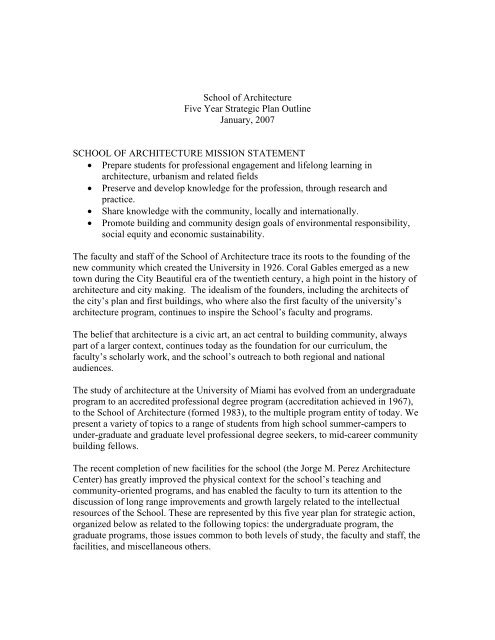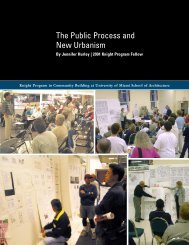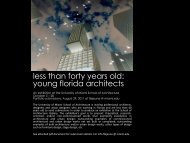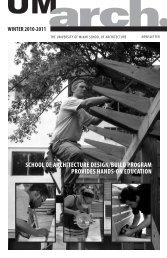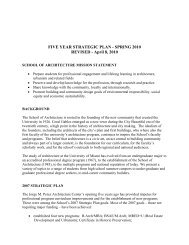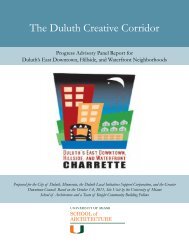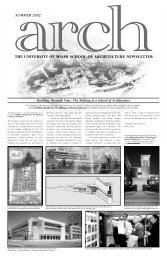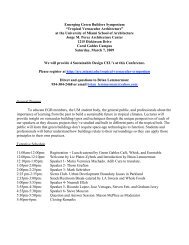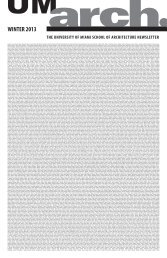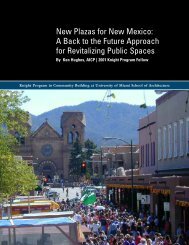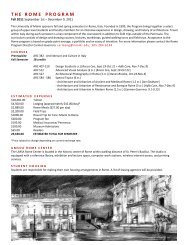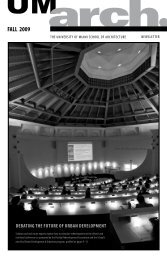School of Architecture Five Year Strategic Plan Outline January ...
School of Architecture Five Year Strategic Plan Outline January ...
School of Architecture Five Year Strategic Plan Outline January ...
Create successful ePaper yourself
Turn your PDF publications into a flip-book with our unique Google optimized e-Paper software.
<strong>School</strong> <strong>of</strong> <strong>Architecture</strong><br />
<strong>Five</strong> <strong>Year</strong> <strong>Strategic</strong> <strong>Plan</strong> <strong>Outline</strong><br />
<strong>January</strong>, 2007<br />
SCHOOL OF ARCHITECTURE MISSION STATEMENT<br />
Prepare students for pr<strong>of</strong>essional engagement and lifelong learning in<br />
architecture, urbanism and related fields<br />
Preserve and develop knowledge for the pr<strong>of</strong>ession, through research and<br />
practice.<br />
Share knowledge with the community, locally and internationally.<br />
Promote building and community design goals <strong>of</strong> environmental responsibility,<br />
social equity and economic sustainability.<br />
The faculty and staff <strong>of</strong> the <strong>School</strong> <strong>of</strong> <strong>Architecture</strong> trace its roots to the founding <strong>of</strong> the<br />
new community which created the University in 1926. Coral Gables emerged as a new<br />
town during the City Beautiful era <strong>of</strong> the twentieth century, a high point in the history <strong>of</strong><br />
architecture and city making. The idealism <strong>of</strong> the founders, including the architects <strong>of</strong><br />
the city’s plan and first buildings, who where also the first faculty <strong>of</strong> the university’s<br />
architecture program, continues to inspire the <strong>School</strong>’s faculty and programs.<br />
The belief that architecture is a civic art, an act central to building community, always<br />
part <strong>of</strong> a larger context, continues today as the foundation for our curriculum, the<br />
faculty’s scholarly work, and the school’s outreach to both regional and national<br />
audiences.<br />
The study <strong>of</strong> architecture at the University <strong>of</strong> Miami has evolved from an undergraduate<br />
program to an accredited pr<strong>of</strong>essional degree program (accreditation achieved in 1967),<br />
to the <strong>School</strong> <strong>of</strong> <strong>Architecture</strong> (formed 1983), to the multiple program entity <strong>of</strong> today. We<br />
present a variety <strong>of</strong> topics to a range <strong>of</strong> students from high school summer-campers to<br />
under-graduate and graduate level pr<strong>of</strong>essional degree seekers, to mid-career community<br />
building fellows.<br />
The recent completion <strong>of</strong> new facilities for the school (the Jorge M. Perez <strong>Architecture</strong><br />
Center) has greatly improved the physical context for the school’s teaching and<br />
community-oriented programs, and has enabled the faculty to turn its attention to the<br />
discussion <strong>of</strong> long range improvements and growth largely related to the intellectual<br />
resources <strong>of</strong> the <strong>School</strong>. These are represented by this five year plan for strategic action,<br />
organized below as related to the following topics: the undergraduate program, the<br />
graduate programs, those issues common to both levels <strong>of</strong> study, the faculty and staff, the<br />
facilities, and miscellaneous others.
I<br />
Common to Graduate and Undergraduate Program<br />
1. Adjust curriculum to increase students’ exposure to new urbanism and green<br />
building<br />
Two topics <strong>of</strong> increasing pr<strong>of</strong>essional importance require more explicit technical<br />
instruction than currently available in coursework.<br />
Y1 review coursework required and implement<br />
Program Directors<br />
2. Explore curriculum options for new collaborations with other programs<br />
The undergraduate program requires a minor outside the school and classes are taught<br />
jointly with faculty from the Architectural Engineering, and Science and Policy; faculty<br />
have expressed an interest in additional interaction with Civil Engineering and the Center<br />
for Hemispheric Policy. Medicine.<br />
Y1 review options and assign faculty responsibility for correspondence with other<br />
divisions; establish and re-establish secondary appointments with other divisions<br />
Program Directors, Advancement<br />
3. Develop information literacy agenda working with new architecture<br />
librarian, New Urbanism<br />
The hiring <strong>of</strong> a new librarian (by Richter Library in a search which involves <strong>School</strong><br />
faculty) to fill the vacated position in the <strong>School</strong> library <strong>of</strong>fers the opportunity to provide<br />
a new type <strong>of</strong> instruction in research and writing skills.<br />
Y1 hire librarian; select faculty to work with librarian to develop curriculum component<br />
Y2 teach first courses involving information literacy; review and assess results<br />
Y3, 4, 5 expand curriculum <strong>of</strong>ferings; continue assessment<br />
Curriculum Committee<br />
4. Increase student involvement in national competitions and awards programs<br />
Competing nationally for recognition can be an important component <strong>of</strong> design<br />
education. A host <strong>of</strong> student design competitions facilitate the opportunity. Taking<br />
advantage <strong>of</strong> those opportunities requires faculty initiative in studio assignments.<br />
Y1 review and assign faculty responsibility<br />
Y2, 3, 4, 5 assess performance and adjust method as necessary<br />
All Faculty<br />
5. Explore feasibility <strong>of</strong> requiring a semester in Rome for all students<br />
The faculty has for some time discussed the value <strong>of</strong> study in Rome and expanding that<br />
opportunity for all students.<br />
Y1 study budget and teaching resources required; project implementation<br />
Y2, 3, 4, 5 potential implementation<br />
Curriculum Committee<br />
6. Improve graduation rate<br />
Work with students who have 3-12 credits remaining for graduation to develop individual<br />
plans for completion <strong>of</strong> program.
Y1 identify and list students to be addressed and invite students to interviews to tailor<br />
programs<br />
Y2, 3, 4, 5 follow up with students, begin ongoing tracking <strong>of</strong> enrolled students<br />
II<br />
Undergraduate Program<br />
1. Improve quality <strong>of</strong> entering class: increase SAT 75 th percentile score from<br />
1330 to _____________.<br />
This can be partially achieved by the reduction in enrollment, assuming that<br />
admission <strong>of</strong> a smaller class will be more selective.<br />
Y1 1350 Y2 1370 Y3 1390 Y4 1410 Y5 1430<br />
Academic Services: what has been yearly SAT increase<br />
2. Aim for overall five year enrollment goal <strong>of</strong> 340 undergraduates<br />
This assumes maintaining approximate even enrollment in each <strong>of</strong> the program’s five<br />
years. This assumes the normal 10% attrition after the first year (many transfer into<br />
another division in the University) augmented by a similar number <strong>of</strong> transfers into the<br />
third year.<br />
Y1 370 students Y2 Y3 Y4 Y5 340 students<br />
Academic Services<br />
3. Reduce enrollment <strong>of</strong> freshman class from 80 to 70<br />
In recent years, the freshman class has grown beyond our goals for it, as a result <strong>of</strong> an<br />
unpredictable combination <strong>of</strong> freshman admission and transfers from within the<br />
University who enter the B Arch program with the freshman cohort. The larger<br />
enrollment stresses teaching capacity, requiring a high proportion <strong>of</strong> part-time faculty,<br />
and has resulted in an overall school enrollment exceeding the capacity <strong>of</strong> our facilities.<br />
Y1 no change, Y2, Y3, Y4, Y5 70 students<br />
Academic Services: Questions: what is relation <strong>of</strong> SAT to performance and GPA What<br />
SAT will reduction <strong>of</strong> 10 students produce What is current freshman retention rate<br />
4. Consider adding requirement <strong>of</strong> portfolio review for freshman admission<br />
This is a requirement <strong>of</strong> a number <strong>of</strong> our peer schools. Faculty discussion to date<br />
has revolved around the appropriate time for portfolio review: prior to admission or after<br />
a year <strong>of</strong> academic performance as a threshold for continuation.<br />
Y1 review with faculty and decide options<br />
Y2 potential implementation<br />
Y3, 4, 5 assessment <strong>of</strong> portfolio review in terms <strong>of</strong> performance, retention, et al<br />
Undergraduate Director<br />
5. Institute University‘s Quality Enhancement Program (QEP)<br />
The QEP is being developed during the ongoing SACS accreditation process. Assuming<br />
the program will focus on communication skills, a curriculum adjustment will be required<br />
to establish uniform goals and assessment measures for drawing, writing, and speaking<br />
skills.<br />
Y1 participate in University wide QEP discussion
Y2 establish QEP goals for <strong>School</strong> <strong>of</strong> <strong>Architecture</strong>; plan required curriculum revisions<br />
and assessment measures<br />
Y3 implement QEP curriculum<br />
Y4 implement assessment measures; establish annual review <strong>of</strong> <strong>School</strong> QEP<br />
Y5 annual review <strong>of</strong> <strong>School</strong> QEP<br />
Program Directors<br />
6. Vacate studio in Memorial Building; increase studio space at the school<br />
Currently 22 student studio desks are located at 201 Memorial Hall 201 as a result <strong>of</strong><br />
enrollment outgrowing school facilities. The intended enrollment reduction will enable<br />
this number <strong>of</strong> students to be housed once again in the school’s buildings. However,<br />
additional studio space is still needed for a number <strong>of</strong> reasons: for each student work area<br />
as determined by a space study <strong>of</strong> two years ago; for increasing graduate enrollment; and<br />
for the possibility that the large number <strong>of</strong> students currently spending a semester in<br />
Rome may not be sustainable, and we may see the need to accommodate them once again<br />
on campus.<br />
Y1 engage University Housing <strong>of</strong>fice regarding possibility <strong>of</strong> expanding into buildings<br />
adjacent to school<br />
Y2 begin relocation <strong>of</strong> Memorial studio<br />
Y3, 4, 5 continue expansion <strong>of</strong> studio space into surrounding buildings<br />
Associate Dean<br />
III<br />
Graduate Programs<br />
1. Improve quality <strong>of</strong> enrolling class: increase average GRE score from 1080 to ____.<br />
This will require increased attention to recruitment and getting the word out about the<br />
faculty, research, publications, and placement <strong>of</strong> graduates, as well as increased financial<br />
aid. Consider renaming M. Arch. in Suburb and Town Design to M. Arch. in New<br />
Urbanism.<br />
Y1 redesign recruiting strategy and material<br />
Y2 implement new recruiting activities and material<br />
Y3, 4, 5 assess and adjust recruitment, enrollment, and student performance<br />
Academic Services: what has been yearly GRE increase<br />
2. Increase overall graduate programs enrollment from 65 to ____ students<br />
This represents an ideal enrollment: M Arch I, 20 students; M Arch II 5 students;<br />
M Arch S&T, 10 students; M Arch Research Rome, 10 students<br />
Y1 no change; Y2 70 students; Y3 80 students; Y4 90 students; Y5 95 students<br />
Academic Services<br />
3. Increase financial aid for graduate students<br />
Work with university’s Graduate <strong>School</strong> to seek a more effective way to allocate existing<br />
financial aid resources vis a vis yield. Seek additional endowment funds for scholarships.<br />
Y1 revise method <strong>of</strong> allocating financial aid<br />
Y2, 3, 4, 5 assess effects on yield and student performance; adjust method<br />
Advancement
4. Consider adding requirement <strong>of</strong> portfolio for all graduate admission<br />
Y1 review with faculty and decide options<br />
Y2 potential implementation<br />
Y3, 4 assessment in terms <strong>of</strong> student performance<br />
Graduate Director<br />
5. Institute semester in Rome for M Arch I and M Arch II<br />
Currently, a small percentage <strong>of</strong> graduate students participate in the semester in Rome<br />
program. The graduate curriculum has been recently adjusted to enable a larger<br />
participation. Increased financial aid is needed to allow students to take advantage <strong>of</strong> this<br />
opportunity.<br />
Y1 8 students; Y2 10students; Y3 12 students; Y4, 5 15 students<br />
Graduate Director, Academic Services, Advancement<br />
6. Institute M.A. in Real Estate Development and New Urbanism<br />
As an outgrowth <strong>of</strong> the Knight Program in Community Building and its successful<br />
symposium courses, this program is intended to enrich the school’s <strong>of</strong>ferings for<br />
architecture students, increase the appeal <strong>of</strong> its pr<strong>of</strong>essional degree programs, and bring<br />
new support to the school from the development industry. The symposia will be<br />
continued as a component <strong>of</strong> the M.A. as well as for the certificate program.<br />
Y1 present program to University administration for approval and implementation;<br />
continue existing courses as electives; begin recruitment <strong>of</strong> students for fall 2007<br />
Y2 begin coursework for first full class <strong>of</strong> 12 students<br />
Y3 increase enrollment to 24 students; assess first year performance; establish dedicated<br />
faculty line; consolidate staffing need<br />
Y4, 5 continue program and assessment <strong>of</strong> student performance and resulting placement<br />
Knight Program Director, Dean, Graduate Program Director, Advancement<br />
IV<br />
Faculty and Staff<br />
1. Increase national recognition <strong>of</strong> full time faculty from 30% to 60% <strong>of</strong> full-time<br />
faculty<br />
Currently 11 out <strong>of</strong> 31 faculty members are involved with scholarly work or practice that<br />
is recognized outside our region. Several have important but unrecognized design work<br />
which merits acclaim through publication and award programs.<br />
Y1 identify individuals and review initiative required to address recognition venues;<br />
review with faculty criteria for merit salary increases<br />
Y2, Y3, 4, 5 repeat through annual review process<br />
All Faculty<br />
2. Re-balance proportion <strong>of</strong> faculty levels<br />
The distribution <strong>of</strong> full, associate and assistant pr<strong>of</strong>essors is top-heavy with small<br />
representation at the entry level. This is at least in part due to the current high demand in<br />
the pr<strong>of</strong>ession, and requires continuation <strong>of</strong> and creativity in the search for young faculty.<br />
Y1 extend faculty search
Y2,3,4,5 keep balance a priority in faculty composition as faculty come and go<br />
Dean<br />
3. Initiate funding search for named visiting pr<strong>of</strong>essorship in design<br />
Several endowed pr<strong>of</strong>essorships have been included in the school’s Momentum<br />
Campaign list. This represents a renewed fund-raising focus.<br />
Y1 compile new list <strong>of</strong> potential donors; implement cultivation and proposals<br />
Y2, 3, 4, 5 continue until achieved<br />
Dean, Advancement<br />
4. Increase faculty salaries to be competitive with peer group<br />
Y1 assemble comparative information; review and refine criteria for increases; determine<br />
five year goal<br />
Y2, 3, 4, 5 implement phased increase<br />
Dean, Lombard<br />
5. Review organizational structure <strong>of</strong> school staff<br />
Changes in programs, facilities and technology over the last decade point to the potential<br />
for staffing changes to reflect these and for greater efficiency.<br />
Y1 work with Human Resources to assess current condition<br />
Y2 implement restructuring<br />
Dean, Associate Dean<br />
V<br />
Facilities<br />
1. Disperse students’ computer printing and plotting services to facilitate use in<br />
proximity to studios; develop electronic payment system<br />
Y1 determine location for new equipment and install<br />
Associate Dean, IT Manager<br />
2. Model Shop: install dust collector/exhaust system; purchase laser cutter;<br />
plan for expansion<br />
Y1 install dust collector (funded by University)<br />
Y2 seek funding to purchase laser cutter; with Facilities Department begin planning for<br />
future expanded location.<br />
Associate Dean, Model Shop Manager<br />
3. Construct Phase II <strong>of</strong> new facility approved by Trustees in 1998<br />
This is a $1.5 million project that includes elevator tower for building 48 required for its<br />
renovation and for library improvements.<br />
Y1 select and hire architect; begin design; continue fund-raising currently underway<br />
Y2, 3, 4, 5 continue fundraising; begin construction<br />
Dean, Advancement<br />
4. Restore Buildings 48 and 49
Built in 1947 and partially renovated for the new school in 1983, these buildings have<br />
long been in need <strong>of</strong> total renovation. The Real Estate, Campus <strong>Plan</strong>ning and<br />
Construction Department has been setting aside funds for window replacement but a<br />
renovation plan has yet to be drawn up.<br />
Y1 develop a plan for renovation; hire architect (possibly same as for Phase II above);<br />
review funding options with University administration (renovations are not a big naming<br />
draw)<br />
Y2 continue fund-raising<br />
Y3, 4, 5 continue fund-raising; begin construction<br />
Dean, Advancement<br />
5. Combine library, computer lab, and image archive as new learning and<br />
research center<br />
The focused staffing <strong>of</strong> the school’s book, slide and film collections (current search) and<br />
the evolving use <strong>of</strong> computing in the studios, together <strong>of</strong>fer the opportunity to integrate<br />
these facilities and improve and increase the holdings. This requires additional library<br />
space among the school’s facilities.<br />
Y1 hire new librarian; working with Richter Library, develop building program and<br />
propose fund-raising campaign for University approval.<br />
Y2, 3, 4, 5 select and hire architect; begin design for new architecture library; implement<br />
cultivation and proposals to raise funds for new building; reorganize existing school<br />
library to allow phased transfer <strong>of</strong> Richter architecture collection to begin.<br />
Y3, 4, 5 continue fund-raising; begin construction for new facility<br />
Dean, Librarian<br />
VI<br />
Miscellaneous<br />
1. Expand Archive for the New Urbanism<br />
The Archive was established in 2004 with a call for submissions to the members <strong>of</strong> the<br />
Congress for the New Urbanism. Over 300 items are currently shelved and catalogued as<br />
a long term resource for the <strong>School</strong> and for an international community <strong>of</strong> interest. The<br />
Archive expansion required the new librarian’s attention, ongoing outreach and<br />
resources.<br />
Y1 develop method for graduate student TA involvement in ongoing archiving<br />
Y2, 3, 4, 5 continue<br />
Librarian, Dean<br />
2. Re-design web site, identify and train webmaster<br />
Recognized as communication critical to the success <strong>of</strong> the <strong>School</strong>’s student body<br />
ambitions, the web site must reflect the character and quality <strong>of</strong> our programs<br />
Y1 initiate and complete<br />
Dean, Public Relations Director<br />
3. Develop comparative rating system to track school’s standing among peers
The rating <strong>of</strong> architecture schools nationally is virtually non-existent. The school has<br />
been identified as the most prominent on the topic <strong>of</strong> new urbanism. We believe that we<br />
are outstanding in a number <strong>of</strong> other areas and that it is critical to be explicit about this in<br />
order to achieve enrollment goals above.<br />
Y1 select schools and topics to be researched for rating list; begin correspondence with<br />
these schools to seek information; compile and assess results; incorporate as appropriate<br />
in school literature and recruiting<br />
Y2, 3, 4, 5 renew and reassess data annually<br />
Dean, Lombard<br />
4. Hire full-time advancement <strong>of</strong>ficer<br />
The advancement position currently serving the school is shared with the Lowe Museum.<br />
Given the reputation and opportunities that the school currently enjoys, we wager that<br />
full-time attention would more than repay that investment.<br />
Y1 reassign advancement <strong>of</strong>fice responsibilities to provide school with full time fundraising<br />
attention; at year end assess results<br />
Y2 continue; at year end assess results: if wager is lost, school budget will pick up half<br />
advancement salary<br />
Dean, Provost<br />
5. Knight Program: pursue endowment to maintain annual Fellowship and<br />
Charrette programs<br />
The existing program is coming to the end <strong>of</strong> its funding by the Knight Foundation. A<br />
number <strong>of</strong> initiatives are underway to fund its continuation, including the courses in real<br />
estate and new urbanism, and individual funding <strong>of</strong> fellows.<br />
Y1 continue fundraising; consolidate work with charrette communities <strong>of</strong> program’s first<br />
four years to ensure good reputation; assess ability to continue fellowship program<br />
Y2, 3, 4, 5 continue work with emerging real estate and new urbanism graduate program;<br />
assess program ability to produce funds<br />
Dean, Advancement, Knight Program Director<br />
6. Center for Urban and Community Design (CUCD): pursue funding to<br />
dedicate a faculty line and staff support<br />
The CUCD was founded in 1992; its successful post-hurricane community planning work<br />
was parlayed into an ongoing regional resource that has largely relied on minimal grants<br />
and volunteer work from faculty and students to carry out its work. Our ability to<br />
continue in like manner is at risk. The CUCD’s recent engagement with West Coconut<br />
Grove that was funded by USHUD and a foundation showed the effectiveness <strong>of</strong> an effort<br />
under full-time faculty attention.<br />
Y1 assign faculty to study organization and funding <strong>of</strong> similar centers in other schools,<br />
and to produce a plan for the Center; include examination <strong>of</strong> potential collaboration with<br />
Knight Program; develop new fundraising plan<br />
Y2, 3, 4, 5 continue fundraising; implement new organization<br />
Dean, Advancement<br />
7. Develop Annual <strong>School</strong> Publication
A number <strong>of</strong> efforts in past decades have produced iterative publications related to the<br />
<strong>School</strong>’s work, such as New City and Black And White. These are useful for increasing<br />
recognition <strong>of</strong> the <strong>School</strong>’s work. A regular publication will require funding and faculty<br />
time.<br />
Y1 determine mission, organizational structure and schedule for implementation; begin<br />
fund raising<br />
Y2, 3, 4, 5 implement; continue fund raising<br />
Dean, Program Directors, Advancement


